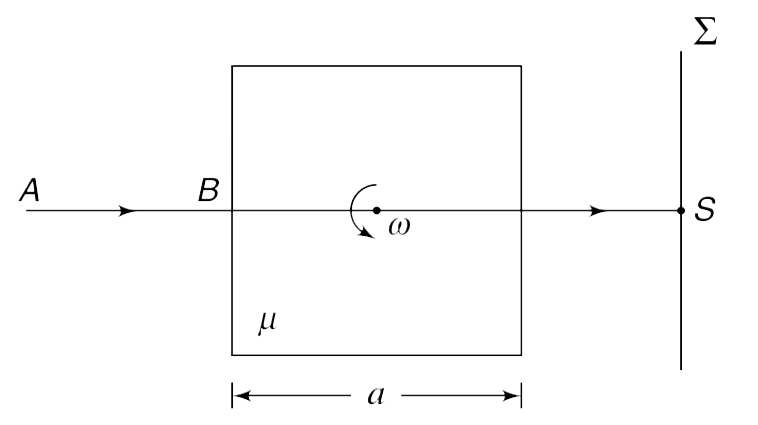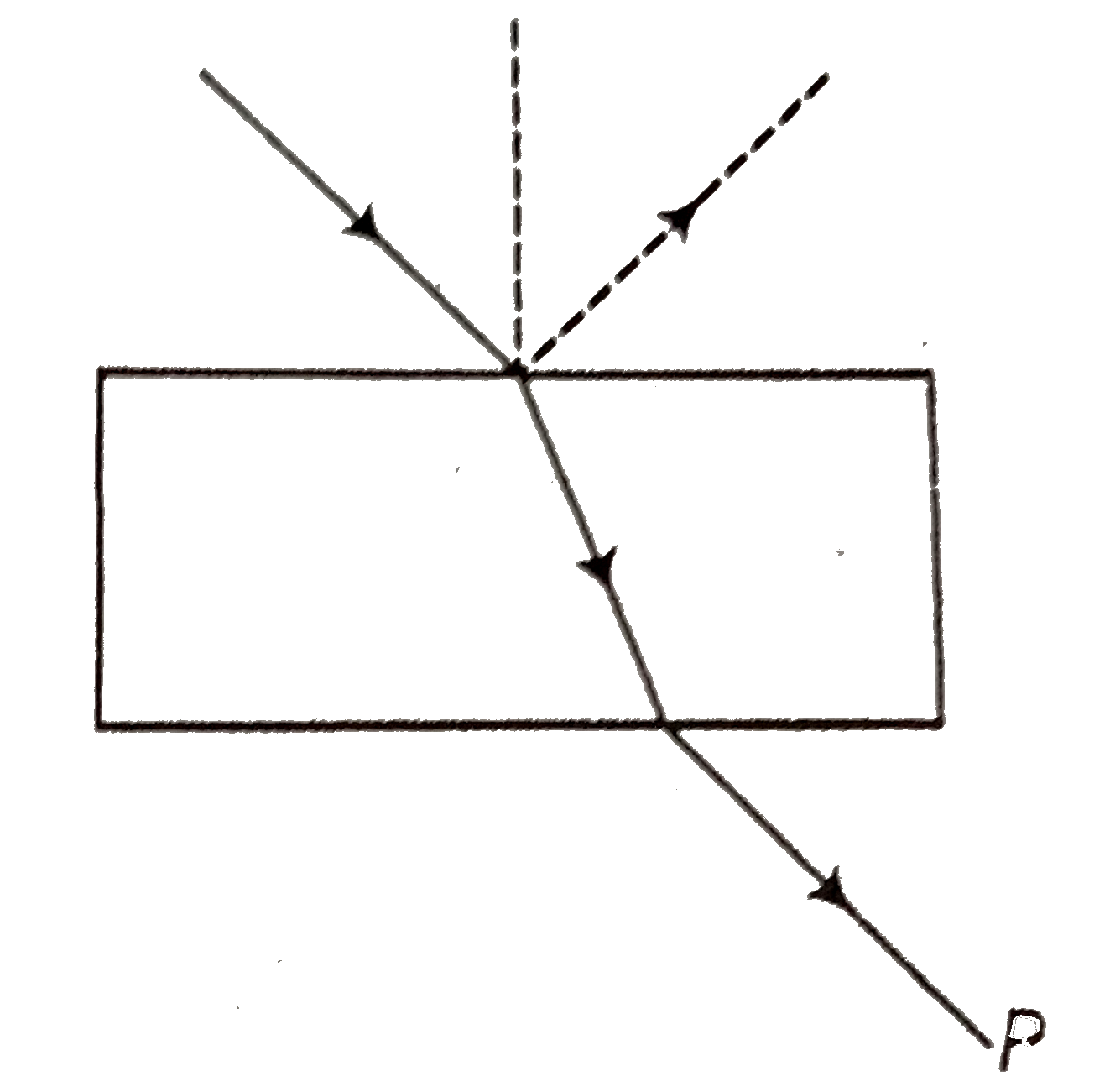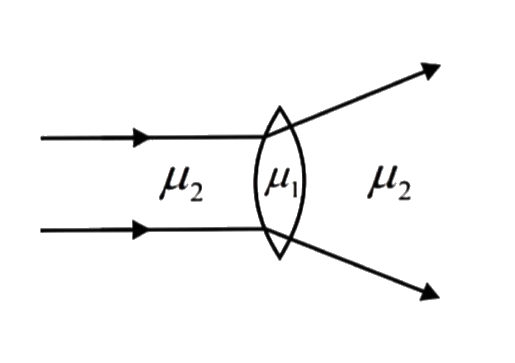A slab of high quality flat glass, with parallel faces, is placed in the path of a parallel light beam before it is focussed to a spot by a lens. The glass is rotated slightly back and forth from the dotted centre about an axis coming out ofthe page, as shown in the diagram. According to ray optics the effect on the focussed spot is:

There is no movement of the spot
The spot moves towards then away from the lens
The spot moves up and down parallel to the lens
The spot moves along a line making an angle a (neither zero nor )with axis of lens
Step by step video & image solution for A slab of high quality flat glass, with parallel faces, is placed in the path of a parallel light beam before it is focussed to a spot by a lens. The glass is rotated slightly back and forth from the dotted centre about an axis coming out ofthe page, as shown in the diagram. According to ray optics the effect on the focussed spot is: by Physics experts to help you in doubts & scoring excellent marks in Class 12 exams.
Topper's Solved these Questions
- BOOK - PHYSICS GALAXY - ASHISH ARORACHAPTER - GEOMETRICAL OPTICSEXERCISE - Numerical MCQs Single Options Correct51videos
GEOMETRICAL OPTICS
- BOOK - PHYSICS GALAXY - ASHISH ARORACHAPTER - GEOMETRICAL OPTICSEXERCISE - Advance MCQs with One or More Options Correct30videos
GEOMETRICAL OPTICS
- BOOK - PHYSICS GALAXY - ASHISH ARORACHAPTER - GEOMETRICAL OPTICSEXERCISE - Discussion Question29videos
GEOMETRICAL OPTICS
- BOOK - PHYSICS GALAXY - ASHISH ARORACHAPTER - ELECTROSTATICSEXERCISE - Unsolved Numberical Problems73videos
ELECTROSTATICS
- BOOK - PHYSICS GALAXY - ASHISH ARORACHAPTER - HEAT AND THERMAL EXPANSIONEXERCISE - UNSOLVED NUMRICAL PROBLEMS FOR PREPARATION OF NSEP, INPhO & IPhO82videos
HEAT AND THERMAL EXPANSION
Similar Questions
A glass cube has side length a and its refractive index is μ=32 . A ray of light (AB) is incident normally on one of its face and after passing through the cube it forms a spot S on screen σ. The cube begins to rotate with angular speed ω about its central axis as shown in the Figure. Immediately after the cube begins to rotate, find the speed of the spot S on the screen.
 View Solution
View SolutionA parallel beam of monochromatic light of wavelength 5900Å falls normally on a convex lens of diameter 10cm which focusses the light on a flat normal screen located at a distance of 20cm from the lens. What would be the radius of the central bright spot formed on the screen?
View Solution
Knowledge Check
- Question 1 - Select One
Consider a light beam incident from air to a glass slab at Brewster's angle as shown in figure.
A polaroid is placed in the path of the emergent ray at point P and rotated about an axis passing through the centre and pependicular to the plane of the plaroid.
 Afor a particular orientation, there shall be darkness as observed through the polaroidBThe intensity of light as seen through the polaroid shall be independent of the rotationCThe intensity of light as seen through the polaroid shall go through a minimum but not zero for two orientations of the polaroidDThe intensity of light as seen through the polaroid shall go through a minimum for four orientations of the polaroid
Afor a particular orientation, there shall be darkness as observed through the polaroidBThe intensity of light as seen through the polaroid shall be independent of the rotationCThe intensity of light as seen through the polaroid shall go through a minimum but not zero for two orientations of the polaroidDThe intensity of light as seen through the polaroid shall go through a minimum for four orientations of the polaroid - Question 2 - Select One
Consider a light beam incident from air to a glass slab at Brewster's angle as shown in Figure.

A polaroid is placed in the path of the emergent ray at point P and rotated an axis passing through the centre and perpendicular to the plane of the polaroid.AFor a particular orientation there shall be darkness as observed through the polaroid.BThe intensity of light as seen through the polariod shall be independent of the rotation.CThe intensity of light as seen through the Polaroid shall go through a minimum but not zero for two orientations of the polaroid.DThe intensity of light as seen through the polaroid shall go through a minimum for four orientations of the polaroid - Question 3 - Select One
A beam of light composed of red and green ray is incident obliquely at a point on the face of rectangular glass slab. When coming out on the opposite parallel face, the red and green ray emerge form
ATwo points propagating in two different directionsBTwo points propagating in two parallel directionsCOne point propagating in two different directionsDOne point propagating in the same directions
A thin bi-convex lens made out of a material of refractive index μ1 is place in a medium of refractive index μ2. A paraxial beam of light, parallel to the principal axis of the lens, is shown in the figure. Based on the ray diagram, we can conclude that
 View Solution
View SolutionA convex lens of focal length 15 cm and a concave mirror of focal length 30 cm are kept with their optic axis PQ and RS parallel but separated in vertical directiion by 0.6 cm as shown . The distance between the lens and mirror is 30 cm . An upright object AB of height 1.2 cm is placed on the optic axis PQ of the lens at a distance of 20 cm from the lens . if A'B' is the image after refraction from the lens and the reflectiion from the mirror , find the distance of A'B' from the pole of the mirror and obtain its magnification . Also locate positions of A' and B' with respect to the optic axis RS.
_E01_247_Q01.png) View Solution
View SolutionAnswer the following questions
(a) In a single slit diffraction experiment, the width of the slit is made double the original width. How does this affect the size and intensity of the central diffraction band?
(b) In what way is diffraction from each slit related to the interference pattern in a double-slit experiment?
(c) When a tiny circular obstacle is placed in the path of light from a distant source, a bright spot is seen at the centre of the shadow of the obstacle. Explain why?
(d) Two students are separated by a 7 m partition wall in a room 10 m high. If both light and sound waves can bend around obstacles, how is it that the students are unable to see each other even though they can converse easily
(e) Ray optics is based on the assumption that light travels in a straight line. Diffraction effects (observed when light propagates through small apertures/slits or around small obstacles) disprove this assumption. Yet the ray optics assumption is so commonly used in understanding location and several other properties of images in optical instruments. What is the justification?View SolutionAnswer the following questions :
(a) In a single-slit diffraction experiment, the width of the slit is made double the original width. How does this affect the size and intensity of the central diffraction band ?
(b) In what way is diffraction from each slit related to the interference pattern in a double-slit experiment?
(c ) When a tiny circular obstacle is placed in the path of light from a distant source,a bright spot is seen at the centre of the shadow of the obstacle. Explain why?
(d) Two students are separated by a 7 m partition wall in a room 10 m high. If both ligth and sound waves can bend around obstacles, how is it that the students are unable to see each other even though they can converse easily ?
(e ) Ray optics is based on the assumption that light travels in a straight line. Diffraction effects (observed when light propagates through small apertures/slits or around small obstacles) disprove this assumption. Yet the ray optics assumption is so commonly used in understanding location and several other properties of locaiton and several other properties of images in optical instruments. What is the justification?View SolutionA ray of light travelling in air incident on a rectangular glass block and emerges out into the air from the opposite face. Draw a labelled ray diagram to show the complete path of this ray of light. Mark the two points where the refractions of light takes place. What can you say about the final direction of ray of light?
View Solution

